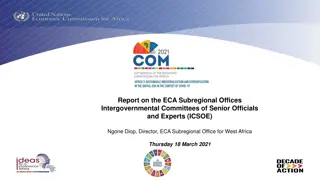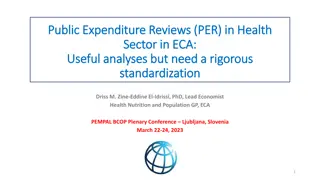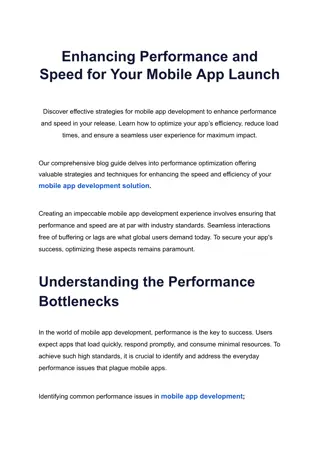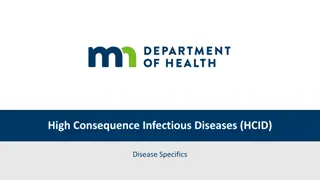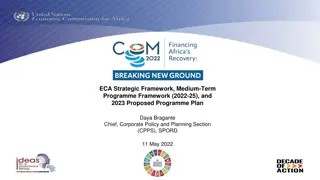
Understanding the Impacts of the Worst EVD Outbreak
Explore the epidemiological situation, key findings, and policy recommendations regarding the worst Ebola outbreak in recent history. Delve into the geographical coverage, affected populations, economic implications, and more, to understand the magnitude of the crisis and the need for a comprehensive assessment and response strategy.
Download Presentation

Please find below an Image/Link to download the presentation.
The content on the website is provided AS IS for your information and personal use only. It may not be sold, licensed, or shared on other websites without obtaining consent from the author. If you encounter any issues during the download, it is possible that the publisher has removed the file from their server.
You are allowed to download the files provided on this website for personal or commercial use, subject to the condition that they are used lawfully. All files are the property of their respective owners.
The content on the website is provided AS IS for your information and personal use only. It may not be sold, licensed, or shared on other websites without obtaining consent from the author.
E N D
Presentation Transcript
Content Background Conceptual Framework Current Epidemiological Situation and Response Some Key Findings Some Policy Recommendations 2
The worst EVD outbreak! Worst outbreak since the disease was diagnosed Geographical coverage and duration Number of people affected Death toll and effect on the bereaved Economic and social implications on affected countries, the region, and the continent Impacts through two main channels: H&F resources for the health and humanitarian response Adverse effect (panic and hysteria) 4
The magnitude of the impacts? Several attempts to quantify the impacts On affected countries: well documented Less focus on West Africa and the continent Most projections on EVD impacts: Scattered data and uncertainty about the future epidemiologic path Strong assumption that the epidemic is likely to spread Do not take into account the ongoing commendable response 5
The need for an ECA assessment! Meaningful full assessment can only be done once the outbreak is contained The current ECA assessment is expected to Short term Contribute to the preparation of countries policy responses for the post epidemic recovery Contribute to the dissemination of country- based primary information on the epidemic and its implications Support ongoing economic and social planning efforts that accompany the current health response Medium and long term
Methodology Descriptive quantitative and qualitative analysis based on primary and secondary data collected in affected countries (ECA Task Team and ES) Survey of non-affected countries to assess their preparedness to a possible EVD outbreak WEFM: to model and analyse the escalating effects of the EVD on West Africa and Africa Statistical text mining: perception of the EVD in the world and the image of Africa 9
Current Epidemiological Situation and Response 10
Key Findings 13
Affected countries EVD is not the biggest killer as compared to past and current diseases (malaria, tuberculosis, HIV/AIDS) Beyond the death toll, the EVD has far reaching economic and social impacts in affected countries Economic impacts: Economic activities record a decline (agriculture, mining, trade, services etc.) Public Finance: lowered revenues and increased expenditures Fiscal deficits Decrease in labor supply and productivity Inflationary pressure Etc. 14
Affected countries Social impacts: Rise in morbidities and mortalities of diseases NOT related to Ebola Educational systems have shot-down A rise in unemployment and commercial closures Some population segments are more affected: rural populations, health workers, women, and children Stigma is growing inside the countries and those saving lives are the most affected 15
Effect on West Africa and the continent 16 ECA simulations based on country data
Vulnerability of health systems Low capacity to react and manage outbreaks Limited knowledge of health personnel Health systems low ranking among government priorities Common characteristics: Under-infrastructured Under-staffed Under-resourced Under-integrated (within the country and region- wide) 17
The role of perceptions Fear factor and related panic (hysteria) for a disease that has no cure: Main channel through which the EVD affects the economy Refuels some assumptions on the assessment of EVD impacts Perceptions and stigma fuel the impacts of the disease: Borders closures and cancellation of flights Cancellation of travels even to countries far away from the epicenter Delayed or cancellation of investments Effective communication: Reduce the impacts on affected and non-affected countries Efforts can be concentrated on combating the outbreak 18
Epidemiological Strengthening African health systems (EVD and other diseases) Financing strategies (incl. domestic) for the health sector in general Develop or strengthen systems for tracking morbidity in the population in real time Strengthening civil CRVS in affected and non- affected countries to inform the prevention and combat against outbreaks 20
Economic Reinforce border health checks rather than shut down borders given the economic impacts G-L-S and their partners: engage in food aid efforts and emergency safety nets to address acute food shortages G-L-S: provide special incentive packages to their farmers to help re-launch their agricultural sectors Bilateral and multilateral creditors: seriously consider cancelling G-L-S external debts G-L-S: recovery contingency plans for quickly reviving their economies (revise their MT and possibly LT national development plans) 21
Social African countries: decentralizing their health services in order to enhance health response capacity locally Social responses should not focus just on individuals directly infected by the virus, but should also consider those indirectly affected Social protection and targeted safety nets should address groups that are disproportionally impacted by the outbreak Ensure that children return to school and that the educational outcomes hurt by EVD are brought back to prior levels Expand economic opportunities for women: Recognizing and compensating women for the unpaid care work they do Providing gender-responsive support services 22
Intangibles AUC, AfDB and ECA: to present more accurate data and information on the disease and its impacts African media: to provide accurate and fact-based accounts on EVD AUC, AfDB, ECA: to prepare a joint, more detailed analysis of the socio-economic, political and cultural impacts of EVD when the crisis is contained African leaders should ensure effective implementation of the decisions of the emergency session of the AU Executive Council: Solidarity with affected countries Breaking the stigmatization and isolation of the countries Strengthening their resilience 23
Download Download the report the report http://www.uneca.org Follow the discussions: ECA_Official #EbolaImpact 24








